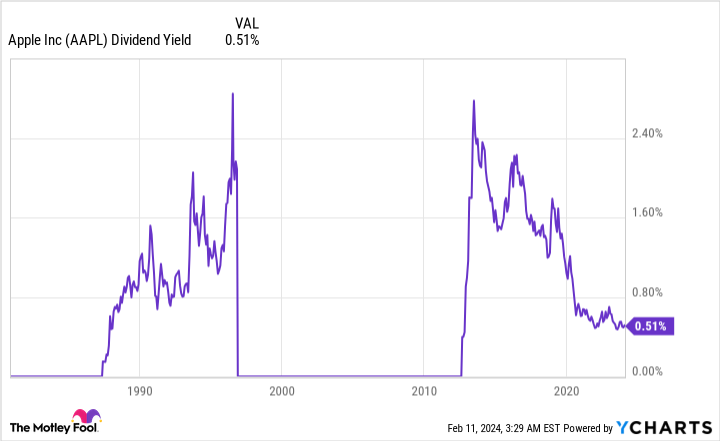Apple (AAPL -0.48%) started paying a dividend again in 2012. It’s raised its payout every year since then, but it still pays a paltry forward yield of 0.5% — which won’t attract any serious income investors when CDs and T-bills sport 5% yields.
But as Apple’s revenue growth slows down, I believe it’s time for the tech giant to significantly boost its dividend to reward its patient investors. Let’s take a look at its free cash flow (FCF) growth to see how much Apple could raise its dividend.
Image source: Apple.
Apple once paid a much higher yield
Apple previously paid dividends from 1987 to 1995. During those eight years, its yield rose from less than 0.5% to more than 2.4% — but it suspended its dividend payments in 1996 as its sales slumped and it turned unprofitable. When Apple started paying dividends again in 2011, it initially paid a forward yield of more than 2.4% — but that percentage slipped back to 0.5% as its stock price rose.
Source: YCharts
Apple likes buybacks more than dividends
Apple also allocated most of its FCF to big buybacks instead of dividends. Over the past five fiscal years (which end in September), it bought back $392 billion in shares but only paid out $73 billion in dividends.
|
Metric |
FY 2019 |
FY 2020 |
FY 2021 |
FY 2022 |
FY 2023 |
|---|---|---|---|---|---|
|
Dividends |
$14.1 billion |
$14.1 billion |
$14.5 billion |
$14.8 billion |
$15.0 billion |
|
Buybacks |
$66.9 billion |
$72.4 billion |
$86.0 billion |
$89.4 billion |
$77.6 billion |
|
Total FCF |
$58.9 billion |
$73.4 billion |
$93.0 billion |
$111.4 billion |
$99.6 billion |
Data source: Apple.
Apple favors buybacks because they consistently reduce its outstanding shares while boosting its earnings per share (EPS). That’s why its EPS rose at a compound annual growth rate (CAGR) of 20% from fiscal 2019 to 2023 when its net income only increased at a CAGR of 15%. Buybacks are also more tax-efficient for investors than dividends, which are taxed as ordinary income.
Those buybacks were also well-timed. Over the past five years, Apple repurchased 16% of its shares as its stock price surged more than 300%.
But it might be time for Apple to shift gears
But over the past six months, Apple’s stock rose only 6% while the Nasdaq Composite advanced 16%. Apple underperformed the market as investors fretted over its slowing sales of iPhones — which fell 2% in fiscal 2023 but still accounted for over half of its total revenue — and bemoaned its lack of near-term catalysts.
For now, analysts expect Apple’s revenue to grow at a CAGR of only 4% from fiscal 2023 to fiscal 2026 as it endures another cyclical downturn in iPhone sales. Its sales of iPads and Macs could also remain soft for the foreseeable future, while the Vision Pro’s high price tag and limited uses could limit its mainstream appeal.
On the bright side, Apple’s services ecosystem continues to grow with more than a billion paid subscriptions, and its $173 billion in cash and marketable securities gives it plenty of ways to expand via big investments and acquisitions. Analysts still expect Apple’s EPS to grow at a CAGR of 8% from fiscal 2023 to fiscal 2026.
Those growth rates are steady, but they might not be sufficient for a stock that trades at 29 times forward earnings. Apple’s valuations were likely inflated by the flight toward safe haven stocks over the past two years — but it could struggle to justify that higher multiple when other stocks offer a better mix of value and growth.
How much can Apple afford to raise its dividend?
Therefore, Apple should consider allocating more of its FCF to dividends instead of buybacks until the next iPhone upgrade cycle starts up again. It spent 78% of its FCF on buybacks and just 15% of its FCF on its dividends in fiscal 2023.
If Apple simply reversed those percentages, it could raise its dividend yield fivefold to about 2.5%. That would make it more comparable to blue chip dividend giants like Cisco Systems and HP, which currently pay forward yields of 3.1% and 3.9%, respectively, and give investors a fresh reason to stick with its stock. Apple probably won’t prioritize its dividends over its buybacks anytime soon, but I think it’s a fresh strategy that deserves a look as its near-term growth slows down.
Leo Sun has positions in Apple. The Motley Fool has positions in and recommends Apple, Cisco Systems, and HP. The Motley Fool has a disclosure policy.




